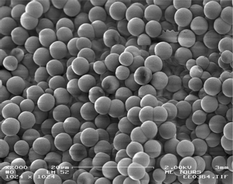The multiplication of terrorist actions in the recent events is alarming and the detection of chemical warfare agents (CWAs) has become one of the highest research priorities in the fields of security and public health. The biomimetic properties of molecularly imprinted polymers (MIPs) render them attractive for molecular recognition as well as sensing purposes. The degradation products of easily hydrolysable organophosphorus nerve agents such as pinacolyl methylphosphonate (PMP), a hydrolysis by-product of soman, are often used as templates in MIP synthesis. In this study, we describe the first example of PMP-imprinted polymer microspheres synthesized by precipitation polymerization. This one-step process involves methacrylic acid (MAA) as the monomer and divinylbenzene (DVB) as the cross-linker, in a toluene/acetonitrile mixture. Subsequent morphological characterizations of the PMP-imprinted particles show that they have diameters between 1 and 10 μm (as opposed to 4–5 μm for the non-imprinted microspheres), surface areas of up to 680 m2 g−1 and high porosities with pore sizes smaller than 2 nm. The present investigation also evidences the imprinting effect via batch binding experiments and reports on the use of a novel fluorescence-based methodology, where 4-methylumbelliferone (4MU) is utilised as a sensing agent to determine the PMP concentration in solution.

You have access to this article
 Please wait while we load your content...
Something went wrong. Try again?
Please wait while we load your content...
Something went wrong. Try again?


 Please wait while we load your content...
Please wait while we load your content...